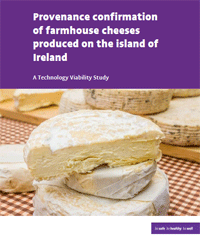Provenance of processed foods is a significant quality attribute for many consumers and one for which they are willing to pay a price premium. As a consequence, the fraudulent mislabeling or adulteration of high-value foods now occurs on a global scale.
 Regulatory authorities and food businesses are focusing greater efforts in combating food fraud which can have serious ramifications for both revenue and reputation.
Regulatory authorities and food businesses are focusing greater efforts in combating food fraud which can have serious ramifications for both revenue and reputation.
A number of provenance verification schemes have been established in other countries with the express purpose of protecting the denomination of quality associated with particular food products. This includes the Grana Padano or Parmigiano-Reggiano protected designation of origin status for artisan cheeses in Italy. There is currently no such scheme for artisan or “farmhouse” cheeses produced on the island of Ireland and yet it is desirable to facilitate a system of provenance confirmation which can provide confidence to consumers in the true geographical origin of artisan cheeses branded as produced on the island of Ireland. It is therefore prudent at this point in time to investigate analytical methods that could be applied to provide consumers with the necessary assurance of the claimed island of Ireland origin of such products.
The concentration and relative ratios of key analytes in a food products such as cheese are mainly influenced by animal diet and geographic location. Several reports from other countries or regions have shown that the use of multivariate analysis of analytical data comprising elemental and isotopic ratio values can provide confirmation of claimed geographic provenance. Given that food animals on the island of Ireland are largely fed a grass-based diet and reside within a discrete insular geographical area, there is potential for developing robust fingerprint models that can characterise indigenous farmhouse cheeses.
Ultimately, the development of robust models will require the demonstration of two properties: (a) models should correctly classify the provenance of all island of Ireland-produced artisan cheeses as originating on the island of Ireland, and (b) models should correctly identify that farmhouse cheeses produced outside the island of Ireland are not of island of Ireland provenance. These two objectives are inseparable in the context of the provenance testing desired and must be demonstrated before any such model can be confidently used in practice. Before this juncture is reached the application of analytical methodologies for the purposes of robust fingerprinting must be investigated.
 This project was a technology viability study that set out to do just that. The strategy pursued generated a considerable quantity of baseline analytical data on the elemental and isotopic composition of island of Ireland artisanal cheese as well as a selection of artisanal cheeses from Great Britain and mainland Europe. While it was not possible to confirm the geographic provenance of island of Ireland artisanal cheeses with 100% accuracy, nonetheless trends in some of the data, especially the isotope data, suggest the possibility of effective segregation of island of Ireland from mainland European, if not Great Britain, cheeses.
This project was a technology viability study that set out to do just that. The strategy pursued generated a considerable quantity of baseline analytical data on the elemental and isotopic composition of island of Ireland artisanal cheese as well as a selection of artisanal cheeses from Great Britain and mainland Europe. While it was not possible to confirm the geographic provenance of island of Ireland artisanal cheeses with 100% accuracy, nonetheless trends in some of the data, especially the isotope data, suggest the possibility of effective segregation of island of Ireland from mainland European, if not Great Britain, cheeses.
Therefore the analytical methodologies investigated have been scoped out for this purpose and can now be taken forward and applied in more focused investigations involving artisan cheeses and other foods produced on the island of Ireland.
